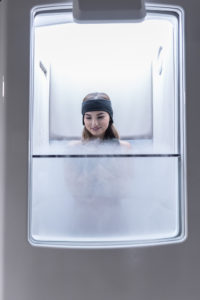Whole Body Cryotherapy FAQs
The following are the most commonly asked questions regarding Whole Body Cryotherapy. If you have any further questions, please ask any Evergreen Cryotherapy employee.

- Is it cold or painful? Yes, it is cold but not painful. The temperatures reach downward to -240F.
- Do I have to wear anything specifically? No, while in the cryochamber you will only be wearing socks, slippers and gloves; women will wear a wrap or shorts/jog bra and men will wear briefs. This allows for 90% of your skin to be exposed to the hyper cool air. You may leave your hair down and have on face lotion or makeup. We ask that you do not apply lotion or any moisture to your skin an hour before your session. No jewelry or metals can be worn.
- How long will my first appointment take? The first appointment with Evergreen Cryotherapy can take anywhere between 15-20 minutes. We like to fully educate our clients and help with any questions they may have. After the first appointment, sessions typically take 5-7 minutes.
- Will I feel anything after my first session? Because the effects of cryotherapy are different for every client, it will depend entirely on how your body reacts to the session. Typically, most clients feel an increase of energy and flexibility and a decrease of inflammation within the first few minutes or hours. Some clients feel the first impact the next morning after a sleep cycle. Many report noticing a deeper sleep and a feeling of reduced pain and inflammation the following 48-72 hours.
- Do I have to do anything specifically after my session? Is there anything I should avoid? No, there is nothing you have to avoid and nothing you should do after your session. Exposure to extreme cold temperatures warms the muscle tissue. This allows our clients to continue their normal tasks throughout the day, typically with more energy.
- Is there anything dangerous about cryotherapy? No, unless conducted by an untrained technician or if you have a contraindication. The cooling agent, nitrogen, is in 78% of the air we breathe every day. Evergreen Cryotherapy’s certified technicians running your sessions are fully trained on safety and operational protocols and are capable of stopping the session if you should want to get out before your session is done. Likewise, there is no lock on the door of the cryochamber so you can step out at any time. Lastly, our CryoArctic cryochamber has a 3-minute auto shut off timer.
- How does the cryochamber get that cold? We use nitrogen to cool the cryochamber to -240F. It is transformed into hyper cool air, which is what cools the chamber and allows it to get into “cryo temperatures.”
- Is it safe to go that cold? Yes, it is. The length of the session is 3 minutes maximum. This short period of time does not allow your body to reach hypothermia.
- How often should I do cryotherapy? This is very dependent on what you are using cryotherapy for. Most clients who are using it for overall health and wellness receive a cryotherapy session 1-2 times a week. Clients who have an injury, inflammation, and aches and pains receive cryotherapy sessions 2-4 times a week.
- Can I use insurance as a form of payment? No, we do not accept insurance policies. You can always ask your insurance provider if they can reimburse you, but we do not accept insurance for payment. Many of our clients use their health savings account cards just like a credit card.
- Is it possible to do it too much? If you notice you are not seeing the same results as when you first started to do cryotherapy sessions, we recommend taking 2 weeks off and then starting over with 1-3 sessions a week. Your body will never become completely used to the effects of extreme cold exposure, but the results will seem less intense with prolonged overuse.
- Are there any limitations on using cryotherapy? Yes, a client under the age of 14 cannot use cryotherapy. The client cannot have high blood pressure, have or have had seizures, have a severe case of Raynaud’s syndrome, be pregnant, have any existing heart issue, have any major vascular issues, have clots or have had a brain aneurism, have any severe reaction to cold or have had a stroke. Other contraindications exist for which each client should fully read the waiver.
